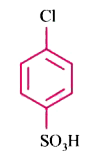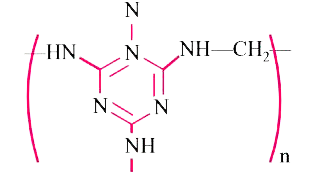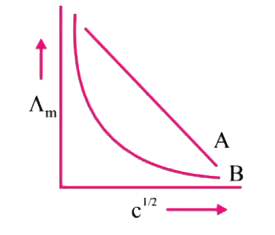Complete Solutions to Questions of chapter PRACTICE PAPER 1 of Class 12 book with complete answers and questions
| Class 12 | CHEMISTRY |
| Chapter | PRACTICE PAPER 1 |
| SUPPORT MATERIAL | Questions |
| Number Of Questions | 82 |
| Academic Year | 2023-24 |
Why are medicines more effective in collidal state ?
View SolutionWhat is differnece between an emulsion and a gel ?
View SolutionArrange the following in increasing order of base strength in gas phase:
`(C_(2)H_(5))_(3)N, C_(2)H_(5)NH_(2), (C_(2)H_(5))_(2)NH`
View SolutionWhy conductivity of silicon increases on doping with phosphorus?
View SolutionWhat is the basic structural difference between glucose and fructose ?
View SolutionProduct obtained by hydrolysis of lactose are
View SolutionWrite IUPAC name of the given compound :

View SolutionWrite structures of compounds A and B in each of the following reactions :

View SolutionWrite structures of compounds A and B in each of the following reactions :

View SolutionFor a reaction : `2H_(2)O_(2)(I^(-))/("alkaline medium")2H_(2)O+O_(2)`
the proposed mechanismis as given below:
(1) `H_(2)O_(2)+I^(-)toH_(2)O+IO^(-)` (slow)
(2) `H_(2)O_(2)+IO^(-)toH_(2)O+I^(-)+O_(2)` (fast)
(i) Write rate law for the reaction.
(ii) Write the overall order of reaction.
(iii) Out of steps (1) and (2), which one is rate determining step ?
View SolutionWrite two differences between an ideal solution and a non-ideal solution.
View SolutionWhen `MnO_2` is fused with KOH in the presence of `KNO_2` as an oxidising agent, it gives a dark green compound (A). Compound (A) disproportionates in acidic solution to give purple compound (B). An alkaline solution of compound (B) oxidises KI to compound (C) whereas an acidified solution of compound (B) oxidises KI to (D). Identify (A), (B), (C), and (D).
View SolutionWrite IUPAC name of the complex `[Cr(NH_(3))_(4)Cl_(2)]^(+)`. Draw structures of geometrical isomers for this complex.
View SolutionUsing IUPAC norms write the formulae for the following :
Pentaamminenitrito-O-cobalt (III) chloride
View SolutionUsing IUPAC norms write the formulae for the following :
Potassium tetracyanidonickelate (II)
View SolutionTwo complex is given as `[CoF_(6)]^(3-) and [Co(C_(2)O_(4))_(3)]^(3-)`, which one complex is:
(i) diamagnetic
(ii) more stable
(iii) outer orbital complex and
(iv) low spin complex? `" " `(Atomic no. Of CO = 27)
View SolutionWrite balanced chemical equations for the following processes :
`XeF_(2)` undergoes hydrolysis.
View SolutionWrite balanced chemical equations for the following processes :
`MnO_(2)` is heated with conc. HCl.
View SolutionArrange the following in order of property indicated for set:
`H_(2)O, H_(2)S, H_(2)Se, H_(2)Te ` - increasing acidic character
View SolutionArrange the following in order of property indicated for set:
`HF, HCl, HBr, HI` - decreasing bond enthalpy
View SolutionAn element crystallizes in fec lattice with a cell edge of 300 pm. The density of the element is 10.8 g `cm^(-3)`. Calculate the number of atoms in 108 g of the element.
View SolutionA 4% solution (w/w) of sucrose (M 342 g `mol^(-1)`) in water has a freezing point of 271.15K Calculate the freezing point of 5% glucose (M= 180 g `mol^(-1)`) in water.
(Given: Freezing point of pure water 273.15 K)
View SolutionThe decomposition of NH, on platinum surface is zero order reaction. If rate constant (k) is `4xx10^(-3) Ms^(-1)`, how long will it take to reduce the initial concentration of `NH_(3)` from 0.1 M to 0.064 M.
View SolutionWhat is the role of activated charcoal in gas mask?
View SolutionA colloidal sol is prepared by the given method in figure. What is the charge on hydrated ferric oxdide colloidal particles formed in the test tube? How is the sol represented?

View SolutionHow does chemisorption vary with temperature.
View SolutionWrite the role of ‘CO’ in the purification of nickel.
View SolutionWhat is the role of silica in the extraction of copper?
View SolutionWhat type of metals are generally extracted by electrolytic method?
View Solution(b) Why do transition metals form alloy ?
View SolutionGive reasons for the following:
`Mn_(2)O_(3)` is basic whereas `Mn_(2)O_(7)` is acidic.
View SolutionGive reasons for the following:
`Eu^(2+)` is a strong reducing agent.
View SolutionWrite the structure of monomers used for getting the following polymers:
Nylon 6, 6
View SolutionWrite the structure of monomers used for getting the following polymers:
Glyptal
View SolutionWrite the structure of monomers used for getting the following polymers:
Buna-S
View SolutionIs `[-CH_(2)-overset(CH_(3))overset(|)(CH)-]_(n)` a homopolymer or copolymer? Give reason.
View SolutionWrite the monomers of the following polymer:

View SolutionWhat is the function of S in the vulcanization of rubber?
View SolutionWhy is bithional added to soap ?
View SolutionBetween sodiumhydrogen carbonate and magnesium hydroxide , which is a better antacid and why ?
View SolutionWhy are detergents non - biodegradable while soap are biodegradable ?
View SolutionDefine terms with a suitable example :
Antibiotics
View SolutionArtificial sweeteners.
View SolutionDefine terms with a suitable example :
Analgesics
View SolutionWrite the structures of main products when benzene diazonium chloride reacts with the following reagents:
(i) CuCN
(ii) `CH_(3)CH_(2)OH`
(iii) KI
View SolutionOut of `(CH_(3))_(3)C-Br and (CH_(3))_(3)C-I`, which one is more reactive towards `S_(N)l` and why?
View SolutionWrite the product formed when p-nitrochlorobenzene is heated with aqueous NaOH at 443 K followed by acidification.
View SolutionWhy dextro and laevo rotatory isomers of Butan-2-ol are difficult to separate by fractional distillation?
View SolutionDifferentiate between the following :
Amylose and Amylopectin
View SolutionDifferentiate between the following :
Peptide linkage and Glycosidic linkage
View SolutionDifferentiate between globular and fibrous proteins.
View SolutionWrite chemical reactions to show that open structure of D-glucose contains the following:
Straight chain
View SolutionWrite chemical reactions to show that open structure of D-glucose contains the following:
Five alcohol groups
View SolutionGlucose contains in addition to aldehyde groups :
View SolutionComplete the following reactions:

View SolutionComplete the following reactions:
`C_(6)H_(5)CH_(2))_(2)Cd+2CH_(3)COCl to `
View SolutionComplete the following reactions:
`CH_(3)-overset(CH_(3))overset(|)(CH)-COOH underset((ii)H_(2)O)overset((i)Br_(2)//"Red "P_(4))to`
View SolutionWrite chemical equations, for the following reactions:
Propanone is treated with dilute `Ba(OH)_(2)`
View SolutionWrite chemical equations, for the following reactions:
Acetophenone is treated with `Zn(Hg)//"Conc. "HCl`
View SolutionHydrogenation of benzoyl chloride in the presence of `Pd//BaSO_4` gives :
View SolutionSulphur vapours exhibit some paramagnetic behaviour. Explain.
View SolutionSingle `N-N` bond is weaker than the single `P-P` bond. This is because of `:`
View SolutionExplain why ozone is thermodynamically less stable then oxgen ?
View SolutionWrite the name of gas released when Cu added to dilute `HNO_(3)`
View SolutionCu reacted to Conc. `HNO_(3)`, which type of gas released during the reaction?
View SolutionGive one disproportionation reaction of phosphorus acid `(H_(3)PO_(3))`.
View SolutionDraw the structure of `XeF_(2)` molecule.
View SolutionAccount for the following:
Although Fluorine has less negative electron gain enthalpy yet `F_(2)` is strong oxidizing agent.
View SolutionAccount for the following:
Acidic character decreases from `N_(2)O_(3)` to `Bi_(2)O_(3)` in group 15.
View SolutionWrite a chemical reaction to test sulphur dioxide gas. Write chemical equation involved.
View Solution`E_("Cell")` for the given redox reaction is 2.71 V
`Mg_((s))+Cu_((0.01 M))^(2+)to Mg_((0.011M))^(2+)+Cu_((s))`
Calculate `E_("cell")` for the reaction. Write the direction of flow of current when an external opposite potential applied is:
(i) less than 2.71 V and (ii) greater than 2.71 V
View SolutionA steady current of 2 amperes was passed through two electrolytic cells X and Y connected in series containing electrolytes `FeSO_(4) and ZnSO_(4)` until 2.8 g of Fe deposited at the cathode of cell X. How long did the current flow? Calculate the mass of Zn deposited at the cathode of cell Y.
(Molar mass : `Fe=56 g"mol"^(-1)Zn=65.3"g mol"^(-1), F=96500"C mol"^(-1)`)
View SolutionIn the plot of molar conductivity (^ m) vs square root of concentration `(c^(1//2))` following curves are obtained for two electrolytes A and B :

Answer the following: (i) Predict the nature of electrolytes A and B.
(ii) What happens on extrapolation of ^ m to concentration approaching zero for electrolytes A and B?
View SolutionHow do you convert the following :
Phenol to Anisole
View SolutionHow will you convert ethanol to propan-2-ol ?
View SolutionExplain the mechanism of the following reaction:
`CH_(3)CH_(2)OH overset(H^(+)) underset(443K) to CH_(2)=CH_(2)+H_(2)O`
View SolutionWhy phenol undergoes electrophilic substitution more easily than benzene?
View Solutiono-nitrophenol is more volatile than p-nitrophenol it is due to
View SolutionAccount for the following:
t-butyl chloride on heating with sodium methoxide gives 2-methylpropene instead of t-butylmethylether
View SolutionWrite the reaction involved in the following :
Reimer-Tiemann reaction
View SolutionWrite the reaction involved in the following :
Friedal-Crafts Alkylation of Phenol
View SolutionGive simple chemical test to distinuish between Ethanol and Phenol.
View Solution
Questions questions and complete solutions for chapter PRACTICE PAPER 1 of CBSE COMPLEMENTARY MATERIAL CHEMISTRY (HINGLISH) of Class 12